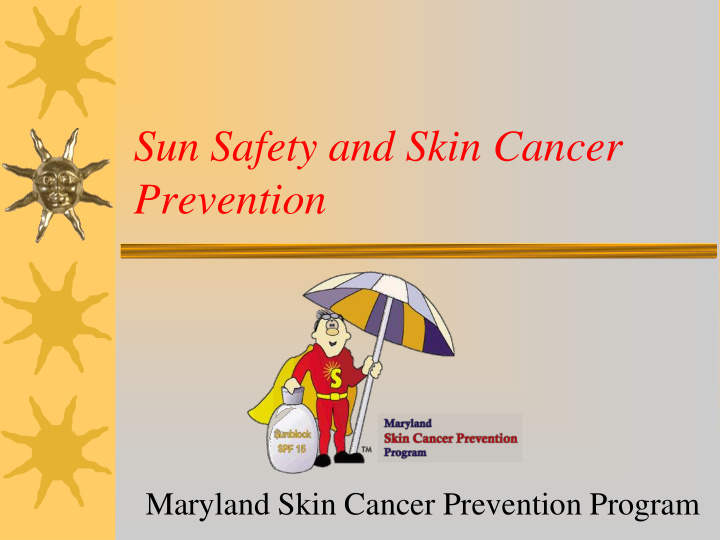



Sun Safety and Skin Cancer Prevention Maryland Skin Cancer Prevention Program
Do You Know the Facts About Skin Cancer? Skin cancer is the most common cancer but also the most preventable Childhood sunburn is the most common cause of skin cancer More than 3.5 million skin cancer cases are diagnosed in the US each year One in every two cancers is skin cancer One in every five Americans will develop skin cancer during a lifetime
What Causes Skin Cancer? Skin color is determined by activity level of melanocytes in epidermis UV radiation causes increased activity in melanocytes, releasing the pigment producing substance called melanin : causes freckles, tanned and sunburned skin Sometimes this leads to changes in cell structure and function: causing cancer
Ultraviolet (UV) Radiation and its Effects UVA rays: longer and cause wrinkling and tanning UVB rays: shorter and cause burning UVC rays: are burned up upon entering the earth’s atmosphere
ULTRAVIOLET RAYS: UVA & UVB rays from the sun cause skin damage. UVB rays cause sunburns UVA rays don’t burn but penetrate more deeply and cause wrinkling and tanning
The Dangers of UV Radiation Overexposure to UV Radiation causes: Sunburn Freckling Tanning Premature aging (wrinkles) Skin Cancer Cataracts Immune system depression
When is UV Radiation Most Intense? In the middle of the day (Between 10 a.m. and 4 p.m.) During the summer months At higher altitudes In regions of the earth closer to the equator UV can penetrate more than 3 ft. of water Use the UV Index as a tool to help plan your outdoor activities.
Do You Know the Three Main Types of Skin Cancer? Basal Cell Carcinoma 75% of all skin cancers Squamous Cell Carcinoma 20% of all skin cancers Melanoma 5% of all skin cancers but is responsible for 75% of skin cancer deaths
Facts about Melanoma Melanoma rates are rising faster than any other cancer in the U.S. and have doubled in the last 30 years. While mortality from most cancers is down, melanoma mortality rates continue to rise. About 1,420 cases of melanoma will be found in Maryland this year Approximately 9,000 people in the U.S. will die this year from malignant melanoma = one person/hour
Melanoma Incidence & Mortality by Year of Diagnosis or Death, Maryland 2001-2006 Ref: Maryland DHMH Cancer Report 2010 Age- adjusted rate per 30 25 21.7 21.3 100,000 pop. 19.7 19.4 18.7 18.6 20 15 10 5 3 2.8 2.8 2.7 2.7 2.5 0 2001 2002 2003 2004 2005 2006 g Year of Diagnosis or Death Incidence Mortality
Melanoma Rates by Maryland Region: 2002-2006 Maryland Rate = 20.2 per 100,000 Ref: Maryland DHMH Cancer Report 2010 28.9 35 Rates per 100,000 pop. 25.5 30 19.7 23.4 25 20 13.4 15 10 5 0 Baltimore Eastern Shore National Northwest Southern Metro Capital Maryland Region
Why Are Skin Cancer Rates Rising? Social acceptability of a tan More leisure time Less clothing worn Depletion of ozone layer Use of artificial tanning sources Earlier sun damage now showing up as skin cancer
Changes in Fashion Through the Years and Melanoma Risk In the early 1900’s, the lifetime risk of melanoma was 1/1500 In 2001 the lifetime risk of melanoma was 1/710 In 2015 the lifetime risk of melanoma will be 1/50
Signs of Melanoma What are the ABCD’s? Asymmetry Border Color Diameter CHANGE!
Who is at Risk for Skin Cancer? Fair skin, burns easily Light hair, red hair Blue, green or hazel eyes Freckles Many moles Family history
Protective Measures Avoid midday sun Cover up Use sunscreen Apply liberally and often Avoid reflective surfaces Seek shade in the middle of the day Avoid tanning beds
Sunscreen Use SPF 15 or higher, broad spectrum (UVA/UVB) Apply 20 minutes before going outside Use 1 ounce per application Reapply every 2 hours or more often if swimming or sweating
SPF Explained Sun Protection Factor (SPF) Minimum SPF of 15 recommended - When applied properly and reapplied often, this is sufficient for most skin types. SPF 30 is NOT twice as effective as SPF 15. SPF 15 protects you from 93% of harmful UVB rays; SPF 30 from 97%. Higher SPF sunscreens don’t really give you a lot more protection for your dollar! Use sunscreen with physical blockers like zinc oxide for non-allergic and immediate protection.
Dispelling a Common Myth Myth: But a good “base tan” will protect me from sunburns and sun damage! Fact: A tan is the skin’s response to injury. There is no such thing as a healthy tan.
Tanning Beds are NOT Safe! Studies show tanning beds are linked to skin cancer and premature aging Indoor tanning lamps emit UVA and UVB radiation at levels that can be as much as 15 times stronger than the sun If you must be tan, use a self tanner. You still must use sunscreen
Tanning Beds and Minors Melanoma rates have risen 50% among young women since 1980 37% of 17 year old girls report using tanning beds Using a tanning bed before age 35 increases melanoma risk by 75% Since October 1, 2008 minors need in-person parental consent to use a tanning facility in Maryland
Any lifeguards out there? This is an 84 year old former lifeguard from Australia. Each orange dot represents a removed skin cancer lesion. He has over 500 on his body!!
How the Dermascan Works The standard photo shows what your skin looks like on the surface The UV photo looks deeper, showing the sun damage you can’t see in the mirror The spots in the UV photo show the extent of skin damage due to sun exposure
Severe Sun Damage Makes You at Higher Risk for Skin Cancer This woman is only 64 years old. The Dermascan shows the damage to her skin from too much unprotected sun exposure.
Maryland Skin Cancer Prevention Program www.sunguardman.org Contact Roberta Herbst, M.S. rherbst@medchi.org or 410.539.0872 x3340
Recommend
More recommend